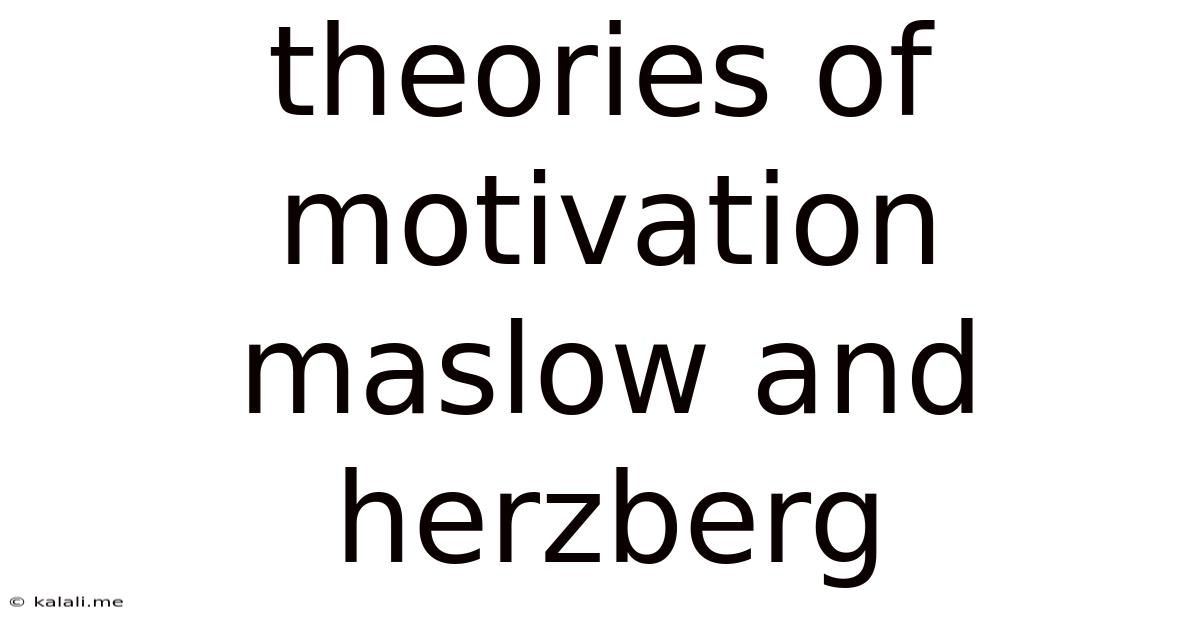Theories Of Motivation Maslow And Herzberg
Kalali
Jun 11, 2025 · 4 min read

Table of Contents
Understanding Employee Motivation: Maslow's Hierarchy and Herzberg's Two-Factor Theory
Understanding what motivates employees is crucial for any successful business. A highly motivated workforce is more productive, creative, and committed. Two prominent theories offer valuable insights into employee motivation: Maslow's Hierarchy of Needs and Herzberg's Two-Factor Theory. This article will explore both, comparing and contrasting their key concepts and practical applications.
Maslow's Hierarchy of Needs proposes that human motivation is based on a hierarchy of five needs, progressing from basic physiological needs to self-actualization. Understanding these levels can help managers tailor incentives and create a motivating work environment.
The Five Levels of Maslow's Hierarchy:
-
Physiological Needs: These are the most basic needs, including food, water, shelter, and sleep. In a work context, this translates to fair wages, comfortable working conditions, and reasonable work hours. If these needs aren't met, employees will be preoccupied with survival and unable to focus on higher-level needs.
-
Safety Needs: Once physiological needs are met, safety needs become paramount. This includes security, stability, and protection from harm. In the workplace, this means job security, health insurance, and a safe working environment. A lack of safety nets can lead to anxiety and decreased productivity.
-
Love and Belonging Needs: These involve social needs, such as the desire for friendship, intimacy, and a sense of belonging. At work, this translates to teamwork, camaraderie, and a positive work culture. Feeling accepted and valued by colleagues fosters a sense of community and increases motivation.
-
Esteem Needs: Once social needs are met, individuals strive for esteem, including self-respect, confidence, and recognition from others. In a workplace setting, this can be achieved through promotions, awards, responsibility, and public acknowledgment of achievements. Recognition boosts morale and encourages further efforts.
-
Self-Actualization Needs: This is the highest level of the hierarchy and involves realizing one's full potential, pursuing personal growth, and achieving self-fulfillment. For employees, this might mean opportunities for learning, development, and challenging assignments that allow them to utilize their skills and talents to the fullest.
Herzberg's Two-Factor Theory, also known as the motivation-hygiene theory, offers a different perspective on employee motivation. Instead of a hierarchical structure, Herzberg identified two distinct sets of factors that influence job satisfaction and motivation.
Herzberg's Two Factors:
-
Hygiene Factors: These are factors that prevent dissatisfaction but don't necessarily cause satisfaction. They are contextual factors related to the work environment rather than the work itself. Examples include company policies, salary, working conditions, supervision, and interpersonal relationships. While inadequate hygiene factors can lead to dissatisfaction, improving them only eliminates dissatisfaction, not necessarily increasing motivation.
-
Motivators: These factors are intrinsically linked to the job itself and are crucial for job satisfaction and motivation. They include achievement, recognition, responsibility, advancement, and the work itself. Motivators are directly related to the work's content and provide a sense of accomplishment and personal growth.
Comparing Maslow and Herzberg:
While both theories offer valuable insights, they differ in their approach. Maslow's hierarchy is a sequential model, suggesting that lower-level needs must be met before higher-level needs become motivating. Herzberg's theory, however, suggests that hygiene factors and motivators operate independently. Addressing hygiene factors prevents dissatisfaction, but true motivation comes from fulfilling motivators.
Practical Applications:
Both theories offer practical implications for managers:
- Understand individual needs: Recognize that employees have diverse needs at different stages of their lives and careers.
- Create a positive work environment: Address hygiene factors to eliminate dissatisfaction and create a supportive and safe work environment.
- Provide opportunities for growth: Offer challenging assignments, training, and development opportunities to fulfill employees' motivators and higher-level needs.
- Recognize and reward achievements: Publicly acknowledge and reward employees' contributions to foster a sense of accomplishment and esteem.
- Promote teamwork and collaboration: Build a strong team spirit to meet social needs and foster a sense of belonging.
By understanding and applying the principles of Maslow's Hierarchy of Needs and Herzberg's Two-Factor Theory, managers can create a more motivated and productive workforce, leading to increased employee engagement and overall organizational success. The key is to tailor strategies to individual employee needs and the specific context of the workplace.
Latest Posts
Latest Posts
-
If I Am 16 What Year Was I Born
Jul 01, 2025
-
Factors Of 30 That Can Add Up To 19
Jul 01, 2025
-
How Long Does Mail Take In The Same State
Jul 01, 2025
-
How Old Is Someone Born In 1962
Jul 01, 2025
-
How Many Yards Are In 60 Feet
Jul 01, 2025
Related Post
Thank you for visiting our website which covers about Theories Of Motivation Maslow And Herzberg . We hope the information provided has been useful to you. Feel free to contact us if you have any questions or need further assistance. See you next time and don't miss to bookmark.